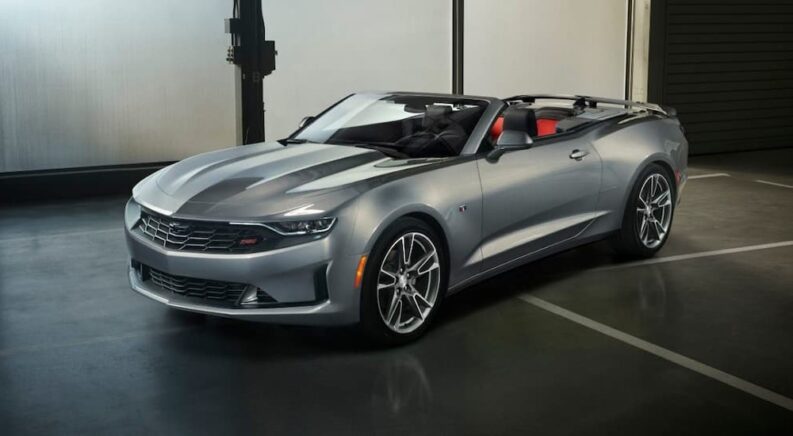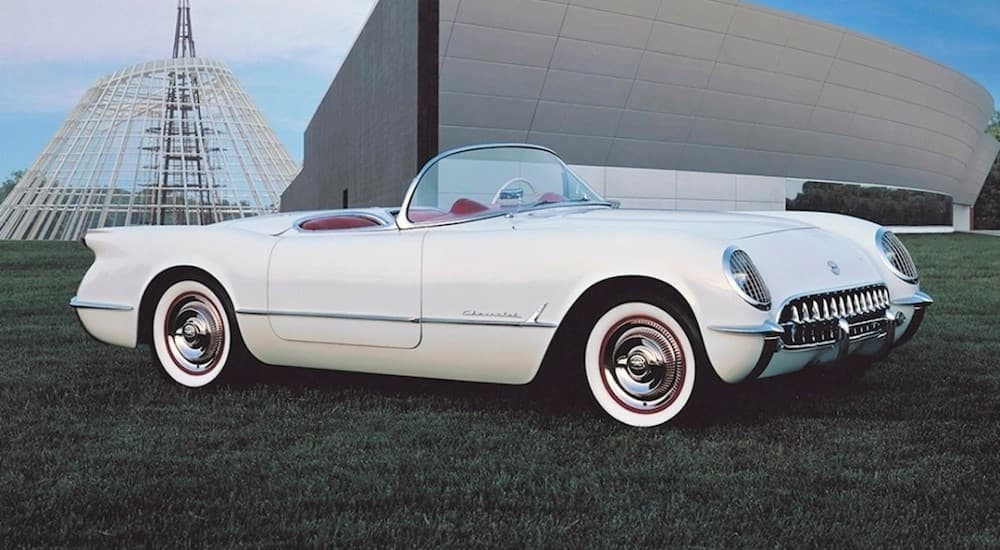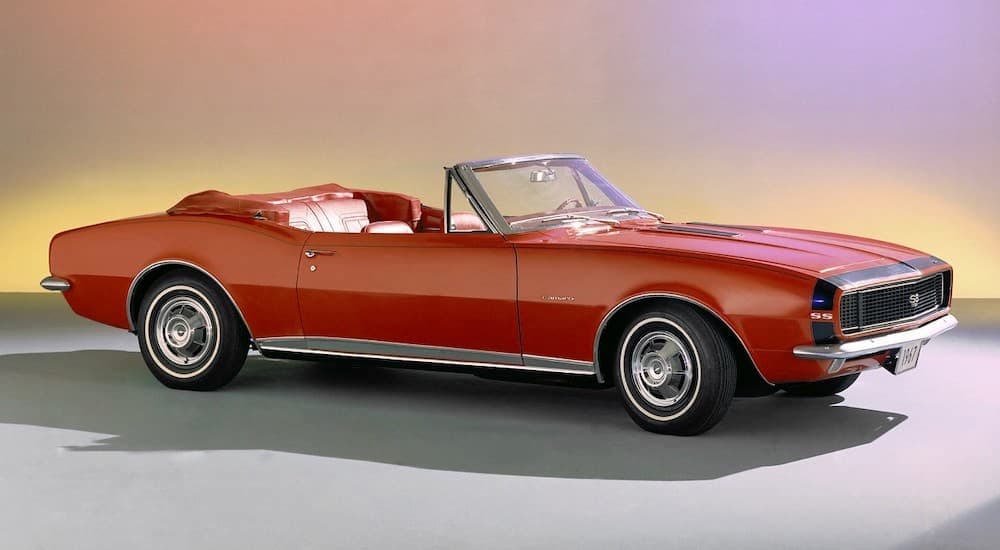Shopping for a vehicle on a budget can be a frustrating task. You might think you’ve found the car, truck, or SUV of your dreams, only to be let down when you spot the sticker price. If you’re on the hunt for a sporty vehicle, the process can be even more disheartening as new, high-performance vehicles tend to skew toward expensive. While it’s easy to succumb to these economic realities and leave the lot driving the first thing on four wheels you find, we have one (hyphenated) word for you: pre-owned. The used market is replete with an array of exciting—and affordable—sports and muscle cars that allow drivers to live out their high-speed dreams without taking out a second mortgage.
Sure, some classic used sports cars have achieved collector’s status, with a price tag to match, but if you’re willing to look back a few model years or generations, you’re sure to find some steals that will put that “wind in your hair feeling” well within reach. If you’re in the market for cheap used cars, the Chevy Camaro and Corvette are two such beauts to be on the lookout for, with used models offering drivers an opportunity to experience the feeling of pure American muscle. Let’s take a closer look at each model, note which years and trims offer the best value, and see why Chevy is such a good choice for those seeking an affordable used sports car.
Chevy Corvette
If you’re looking to max out the RPMs, the Chevy Corvette is hard to ignore. This luxury two-seater has been turning heads since it first hit the streets back in 1953. The Corvette has long been Chevy’s playground for high-performance innovation, allowing the automaker to test out the latest and greatest in automotive tech and letting drivers reap the rewards.
Just take the original Corvette, for example. Chevy pulled out all the stops in bringing this innovative sports car to market, making the Corvette one of the lightest offerings in the segment by turning to a new, cutting-edge technology: fiberglass. Chevy technicians applied the astoundingly light material by hand, making the Corvette the first production car to feature a fiberglass body and giving the sports car a power-to-weight ratio that was tough to beat.
Chevy has never lost the spirit of innovation that made the Corvette such a phenomenon upon its debut, constantly reimagining this sports car and updating it with all the features drivers have come to expect from the segment. That approach has allowed Corvette to outlast most of its competitors and claim the unique title of being the only two-seat sports car still produced by a major US automaker.
Currently, in its eighth generation—known as C8 in Chevy-speak—the 2023 Corvette is well outside the sub-$30,000 budget we’ve set with a starting price of $65,895. This is no surprise when you consider the Corvette’s 490-hp 6.2L V8 engine, electronic limited-slip rear differential, and eight-speed, dual-clutch automatic transmission, but that doesn’t mean the average driver can’t get a taste of the Corvette lifestyle. The preowned market is full of quality used Corvettes; it’s just a matter of diving far enough into the past to turn up some deals.
The sixth-generation (C6) Corvette represents the sweet spot for buyers looking for a thrilling sports car that won’t break the bank. While C7 Corvettes (2014 through 2019) are still retailing for between $40,000 and $65,000, C7 models (2005 through 2013) can be had for just $19,000 to $38,000—though if we’re to keep to our budget, we’ll have to stick to those produced between 2005 and 2009.
The C7 Corvette represents an interesting point in the model’s history. In the past, Chevy has used a new generation as an excuse to completely redesign the classic sports car, but the C7 was a bit of a departure. Described by MotorTrend as an “evolution of the C5, instead of a complete redo”, the C7 Corvette saw Chevy make some modest—but nonetheless important—changes that brought the model firmly into the modern era. Gone were the Corvette’s famous retractable headlights, replaced for the first time since 1962 with a fixed version, but it was the C7 Corvette’s engine that grabbed all the headlines.
The bowtie brand swapped out the LS1 engine found on some previous Corvette models with a new offering dubbed LS2. With a 0.3-liter bump in displacement over the LS1, the C7 came packed with 400 lb-ft of torque and 400 hp—fifty more horses than the C6. The new, beefier engine gave the C7 a zero-to-sixty time of under 4.2 seconds and a top speed of 190 mph. With that sort of power at your disposal, it’s easy to get up to some high-speed hijinks in the C7 Corvette.
Chevy would follow up the LS2 with the LS3 engine starting in 2008, upping the horsepower to 430 while providing 425 lb-ft of torque. Chevy also tinkered with the Corvette’s transmission improving the shift linkages for the six-speed manual transmission and shortening the shifting points for the four-speed automatic.
Chevy followed the 2005 C7 with a new, high-performance Z06 variant in 2006. Its massive 505-hp 7.0L V8 was, at that time, the largest small block engine ever produced by a General Motors brand. The Z06 boasts a top speed of 198 mph and a zero-to-sixty time of 3.7 seconds—two feats made possible thanks to the model’s novel aluminum body, which weighed almost 150 lbs less than non-Z06 versions.
The Z06 also came standard with a full suite of performance-minded components, from an air inlet integrated into the front bumper to brake cooling ducts, wider rear fenders, and carbon fiber front fenders. The Z06 might be one of the Corvette’s most enticing guises, but finding it for under $30,000 could be a struggle considering it still normally sells for around $40,000 to $50,000.
Chevy Camaro
If you’re in the market for a Chevy Camaro, you’ve got plenty of options to explore. Chevy’s iconic pony car is one of the more affordable sports cars on the market today, with new, coupe-style Camaros starting at less than $30,000. Sure, there are also tons of used Camaro models to choose from, including convertibles and high-performance variants, but if you really value that new car smell, a brand-new Camaro should still be well within your price range.
The 2023 Camaro has a starting price of just $29,000 for the 1LS coupe, which is between $1,500 and $2,000 less than pony car offerings from rivals like Dodge and Ford. One caveat if you’re considering a new Camaro: time is not on your side. Chevy has announced plans to discontinue the legendary sports car after the 2024 model year. While the automaker assures us that it won’t be the last we hear from the Camaro, there’s just no telling what the future might hold. (After all, N*SYNC merely said they were going on hiatus—and where are they now??)
Let’s start by taking a closer look at the 1LS. The Camaro’s base trim is surprisingly well-rounded, especially given its sub-$30,000 price, making this muscle car a real standout in its segment. If you’re wondering how an automaker—even one as experienced as Chevy—managed to produce such an affordable pony car, you’ll find your answer under the hood. The 1LS is powered by a turbocharged four-cylinder engine, making it something of an iconoclast in a segment where V6 and V8 engines tend to dominate.
That’s not to say the 1LS is underpowered. Chevy’s decision to add a turbocharger to the base 2.0L inline-four engine back in 2019 went a long way in upping the model’s street cred, giving drivers 275 hp and 295 lb-ft of torque to play around with. Best of all, the 1LS comes standard with a six-speed manual transmission, allowing drivers to live out their sports car dreams while offering a level of control and connection that only a manual gearbox can provide (though an eight-speed automatic is also offered for an additional $1,495). This setup allows drivers to power the Camaro 1LS from zero to sixty in as little as 5.4 seconds—an important benchmark for any muscle car worth its racing stripes.
The Camaro’s sporty bona fides don’t start and end with the engine. A sport suspension improves overall comfort and control while front and rear stabilizer bars prevent sway, making them a welcome addition to the 1LS trim. Like all Camaro models, the base 1LS trim includes multiple driving modes that will help drivers find success on the track, on wide-open roads, or wherever their Camaro might take them.
Chevy’s StabiliTrak electronic stability control system with traction control ensures the Camaro is locked into its line by constantly monitoring the position of the steering wheel and tires and adjusting the car’s steering, traction, and braking in response. As any driver who has ever spent a little time at the track knows, traction control can go a long way in improving not only performance but safety and stability when you’re cornering at high speeds.
If you’re interested in exploring some of the higher-end Camaro trims, the used market is the place to go. Pre-owned Camaros produced in the last decade can typically be found for between $18,000 and $30,00, making this pony car one of the best values in its class. The 2009 Corvette is a perfect example, as this was the first year that Chevy extended the 1LE package to the Camaro’s base model, adding the turbocharged engine and a host of race-ready components, including four-piston Brembo brake calipers up front, the FE3 Camaro suspension, and Goodyear Eagle F1 tires. These upgrades had a noticeable impact on the overall driving experience, leading industry stalwart JD Power to name the Camaro the Best Midsize Sports Car of 2019. The LT and LS trims can easily be found on the used market for less than $30,000, making the 2019 Camaro one of the best deals in recent memory.
If you’re seeking an affordable, thrilling sports car that will provide a little high-octane excitement without breaking the bank, Chevy has plenty of options worth a closer look. As one of the original purveyors of American muscle, Chevy has built a reputation that few other brands can match, with models like the Corvette and Camaro cementing their place in automotive history. These cars offer all the rubber-burning, engine-revving excitement one would anticipate from a sports car without the eye-watering price tag that puts them so out of reach for most drivers.
Shopping on the used market presents a unique opportunity for those seeking a new Camaro or Corvette. Unlike some used vehicles, Corvettes and Camaros tend to be pretty well taken care of by the enthusiasts who flock to these sporty models, meaning they often still have plenty of good miles left in the tank. This, along with Chevy’s stellar reputation for quality construction, goes a long way in upping the already considerable value of the Corvette and Camaro, making them one of our favorite options for those in the market for an affordable, fast car.






